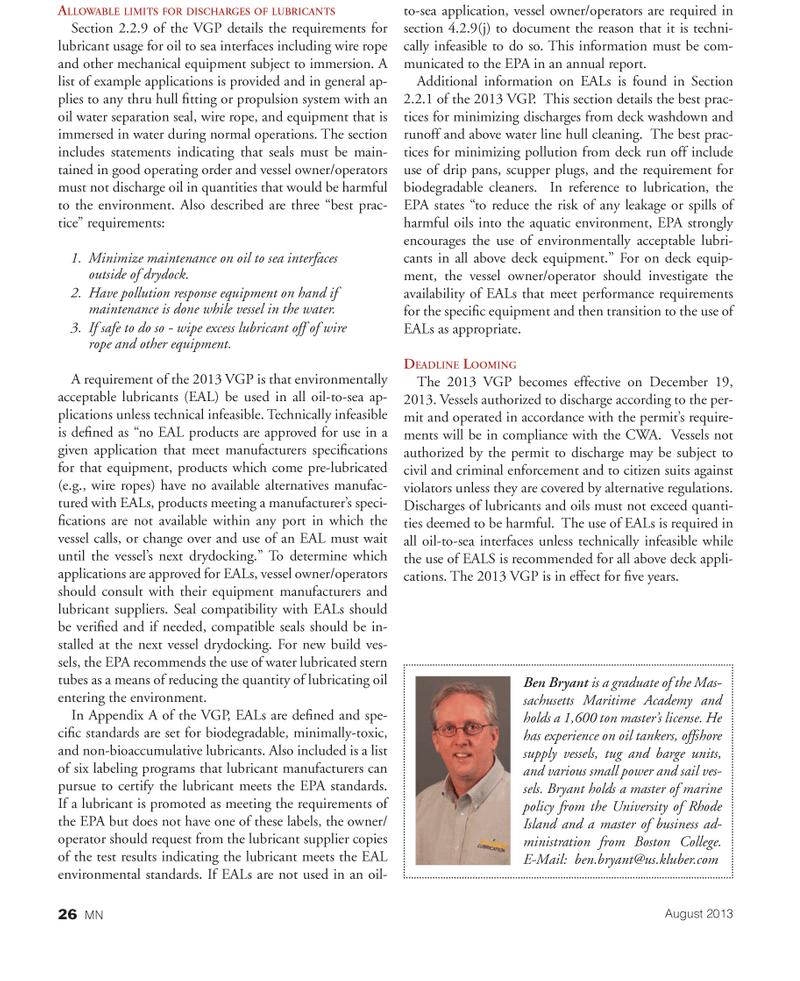
Page 26: of Marine News Magazine (August 2013)
Salvage & Response
Read this page in Pdf, Flash or Html5 edition of August 2013 Marine News Magazine
ALLOWABLE LIMITS FOR DISCHARGES OF LUBRICANTS Section 2.2.9 of the VGP details the requirements for lubricant usage for oil to sea interfaces including wire rope and other mechanical equipment subject to immersion. A list of example applications is provided and in general ap- plies to any thru hull ? tting or propulsion system with an oil water separation seal, wire rope, and equipment that is immersed in water during normal operations. The section includes statements indicating that seals must be main-tained in good operating order and vessel owner/operators must not discharge oil in quantities that would be harmful to the environment. Also described are three best prac- tice? requirements: 1. Minimize maintenance on oil to sea interfaces outside of drydock. 2. Have pollution response equipment on hand if maintenance is done while vessel in the water. 3. If safe to do so - wipe excess lubricant off of wire rope and other equipment. A requirement of the 2013 VGP is that environmentally acceptable lubricants (EAL) be used in all oil-to-sea ap-plications unless technical infeasible. Technically infeasible is de? ned as no EAL products are approved for use in a given application that meet manufacturers speci? cations for that equipment, products which come pre-lubricated (e.g., wire ropes) have no available alternatives manufac- tured with EALs, products meeting a manufacturers speci- ? cations are not available within any port in which the vessel calls, or change over and use of an EAL must wait until the vessels next drydocking.? To determine which applications are approved for EALs, vessel owner/operators should consult with their equipment manufacturers and lubricant suppliers. Seal compatibility with EALs should be veri? ed and if needed, compatible seals should be in- stalled at the next vessel drydocking. For new build ves- sels, the EPA recommends the use of water lubricated stern tubes as a means of reducing the quantity of lubricating oil entering the environment. In Appendix A of the VGP, EALs are de? ned and spe- ci? c standards are set for biodegradable, minimally-toxic, and non-bioaccumulative lubricants. Also included is a list of six labeling programs that lubricant manufacturers can pursue to certify the lubricant meets the EPA standards. If a lubricant is promoted as meeting the requirements of the EPA but does not have one of these labels, the owner/ operator should request from the lubricant supplier copies of the test results indicating the lubricant meets the EAL environmental standards. If EALs are not used in an oil- to-sea application, vessel owner/operators are required in section 4.2.9(j) to document the reason that it is techni- cally infeasible to do so. This information must be com- municated to the EPA in an annual report. Additional information on EALs is found in Section 2.2.1 of the 2013 VGP. This section details the best prac- tices for minimizing discharges from deck washdown and runoff and above water line hull cleaning. The best prac- tices for minimizing pollution from deck run off include use of drip pans, scupper plugs, and the requirement for biodegradable cleaners. In reference to lubrication, the EPA states to reduce the risk of any leakage or spills of harmful oils into the aquatic environment, EPA strongly encourages the use of environmentally acceptable lubri- cants in all above deck equipment.? For on deck equip- ment, the vessel owner/operator should investigate the availability of EALs that meet performance requirements for the speci? c equipment and then transition to the use of EALs as appropriate. DEADLINE LOOMINGThe 2013 VGP becomes effective on December 19, 2013. Vessels authorized to discharge according to the per- mit and operated in accordance with the permits require- ments will be in compliance with the CWA. Vessels not authorized by the permit to discharge may be subject to civil and criminal enforcement and to citizen suits against violators unless they are covered by alternative regulations. Discharges of lubricants and oils must not exceed quanti- ties deemed to be harmful. The use of EALs is required in all oil-to-sea interfaces unless technically infeasible while the use of EALS is recommended for all above deck appli- cations. The 2013 VGP is in effect for ? ve years. Ben Bryant is a graduate of the Mas- sachusetts Maritime Academy and holds a 1,600 ton masters license. He has experience on oil tankers, offshore supply vessels, tug and barge units, and various small power and sail ves- sels. Bryant holds a master of marine policy from the University of Rhode Island and a master of business ad- ministration from Boston College. E-Mail: [email protected] 26 MNAugust 2013MN August2013 Layout 18-31.indd 267/23/2013 7:17:58 PM

 25
25

 27
27
